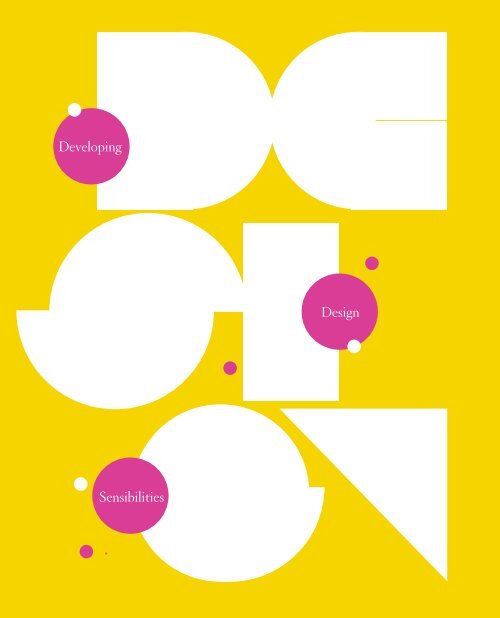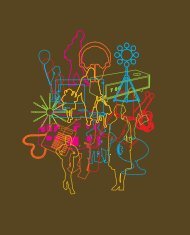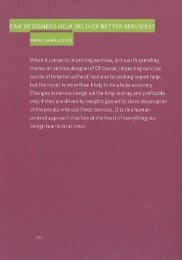Developing Design Sensibilities - Ideo
Developing Design Sensibilities - Ideo
Developing Design Sensibilities - Ideo
You also want an ePaper? Increase the reach of your titles
YUMPU automatically turns print PDFs into web optimized ePapers that Google loves.
<strong>Developing</strong><br />
<strong>Sensibilities</strong><br />
<strong>Design</strong>
y Jane Fulton Suri and R. Michael Hendrix<br />
Effective design thinking entails more than applying design<br />
methods. To produce the best outcomes, organizations need to<br />
develop – and trust – peoples’ design sensibilities.<br />
DESIGN THINKING IS RECEIVING a great deal of attention as<br />
increasing numbers of innovative organizations succeed in solving<br />
complex problems by creative means. In doing so, many of<br />
these firms implement specific ‘design methods’ such as observational<br />
research, iterative prototyping and storytelling alongside<br />
more mainstream approaches. But as any professional designer<br />
will attest, design thinking entails much more than applying<br />
methods: to create value, methods must be applied together with<br />
design sensibilities.<br />
<strong>Design</strong> sensibilities consist of the ability to tap into intuitive<br />
qualities such as delight, beauty, personal meaning and cultural resonance.<br />
Such subtle qualities are difficult to put into words, and thus<br />
are generally discounted in the workplace. Managers schooled in<br />
analytic and rational decision making may find the idea of relying on<br />
their sensibilities uncomfortable. But when coupled with design<br />
methods, design sensibilities create the experiences and outcomes<br />
upon which successful businesses capitalize: clear distinction from<br />
competitors, lasting market impact and customer loyalty.<br />
Cultivating <strong>Sensibilities</strong><br />
Innovation involves making multiple judgment calls about what to<br />
express and how, from a project’s big strategic idea to the fine details<br />
of implementation. <strong>Sensibilities</strong> not only guide these decisions,<br />
they also ultimately influence how people experience the resulting<br />
product, service or brand. Will customers simply end up getting<br />
something that ‘works’, or will they make an emotional connection<br />
Rotman Magazine Spring 2010 / 59
with it – one that entails personal and cultural relevance and<br />
inspires future loyalty?<br />
Take the case of Altoids mints, a favourite example of our colleague<br />
Claudia Kotchka, an accountant-turned-design thinker<br />
who spent more than three decades at Procter & Gamble and now<br />
works as a consultant. In the mid-1990s, Altoids turned a 200-yearold<br />
British stomach remedy into a leading global breath mint by<br />
reinventing its packaging (the now-iconic tin). Kotchka often uses<br />
this example to demonstrate the importance of design sensibilities<br />
to skeptical business teams.<br />
She begins by holding up a tin of Altoids to highlight the product’s<br />
many subtle design qualities – soft corners, rolled edges,<br />
nostalgic typeface, debossed graphics, crinkly paper liner, even the<br />
irregularly shaped and dusty sweets inside – that combine to create<br />
the product’s appeal and sense of authenticity. Then, as chronicled<br />
in a Fast Company article, she enacts a more typical approach, which<br />
might have happened if, say, the pre-Kotchka P&G were to take<br />
over the brand:<br />
“We’re gonna get rid of this stupid paper – it’s serving no functional<br />
purpose.” She plops the tin on the table and picks up another<br />
product, unable to suppress a mischievous smile. “And this is what<br />
you get.’” Kotchka then reveals ‘Proctoids’, a box made of cheap<br />
white plastic from P&G’s baby-wipe containers. With uniform<br />
beige ovals jammed into the container, fewer colours on the lid, and<br />
no paper, Proctoids taste like Altoids, but they look as appealing as<br />
a pile of horse pills. Gone is the pleasure people get when they buy<br />
Altoids. Gone, too, is the up to 400 per cent premium they pay.<br />
“That’s what design is,” she says. “That’s what designers do.”<br />
Just as designers call upon their sensibilities to imagine and create<br />
an experience like Altoids, consumers tap into their sensibilities<br />
to enjoy it. Clearly, going beyond purely functional solutions to<br />
achieve emotionally-resonant ones takes more than analysis and<br />
measurement, but it also takes more than applying design methods.<br />
It takes design sensibilities – judgments informed by sharp intuition<br />
– to bring myriad subjective, complex and subtle qualities<br />
together into a meaningful whole.<br />
Professional designers have invested considerable time and<br />
effort in practicing this kind of integration and refining their sensibilities<br />
in particular ways. In doing so, they become skilled at<br />
synthesizing different factors – what’s viable, feasible, desirable,<br />
sustainable, etc. – and considering multiple permutations of potential<br />
design elements to reach an elegant, holistic solution.<br />
How <strong>Design</strong>ers See<br />
Although every designer brings a unique perspective to the table,<br />
they generally engage with the world in similar ways. Keenly aware<br />
of their surroundings, their observations inform and inspire their<br />
work, often in delicate ways.<br />
Professional designers hold a special responsibility because<br />
they are charged with both sensing opportunities for change and<br />
then expressing that change by manipulating elements to effect that<br />
change. The first of these responsibilities – sensing – is a way of looking<br />
at the people, places and things around us. For instance, have<br />
60 / Rotman Magazine Spring 2010<br />
you ever tried to view the world from someone else’s perspective?<br />
Perhaps you’ve taken a city tour with an architect, admired woodwork<br />
with the guidance of a skilled carpenter, or watched a movie<br />
with a video artist? In all likelihood, their observations were quite<br />
different from yours. <strong>Design</strong>ers’ perceptions reflect an awareness<br />
that our surroundings are created, and of the artistry that goes into<br />
their creation. <strong>Design</strong>ers see physical, cultural and metaphoric<br />
relationships, such as the nooks and crannies where people naturally<br />
gather and the exposed spaces that people avoid, as well as the<br />
atmospheres (welcoming vs. cold) that those tendencies create.<br />
<strong>Design</strong>ers notice the relative placement of graphical elements and<br />
materials in the form of an object and the sensations, memories<br />
(melancholic or joyful) and behaviours to which these give rise. In<br />
short, they are acutely aware of minute details and how small elements<br />
add up to a holistic experience.<br />
<strong>Design</strong>ers also bring a critical eye, detecting and sometimes<br />
becoming offended at designs that don’t work – where details have<br />
been overlooked or dismissed as unimportant and thus undermine<br />
more positive possibilities. Perhaps it’s a product package whose<br />
form and material contradict the verbal message it is trying to convey<br />
about freshness or simplicity; perhaps it’s a hotel that intends<br />
to welcome guests at their journey’s end with a calming experience,<br />
but instead sends them through a maze of unfamiliar distractions<br />
to find their rooms. <strong>Design</strong>ers are able to reframe these misfires as<br />
opportunities to rethink the approach and carry through on a<br />
promise in a more effective, genuine way.<br />
The second design responsibility – expressing – is a means of creating<br />
change by exploiting these perceptions. By valuing and<br />
sharing their observations simply because they seem beautiful,<br />
intriguing, offensive or amusing, designers enrich their intuitions.<br />
Their own subjective awareness of how particular attributes evoke<br />
a sense of beauty, intrigue, ire, or amusement informs the choices<br />
that they make regarding how best to express those qualities in any<br />
given design. In using their sensibilities, designers connect to our<br />
sensibilities and enrich our experience, even when we’re not consciously<br />
aware of it.<br />
Most professionals easily recognize the practical benefits of a<br />
product or service, but they often overlook the less-apparent qualities<br />
of an experience from which they derive pleasure, identity, and<br />
meaning. For example, while industrial designer Jason Robinson,<br />
a colleague of ours, was conceiving a new generation of surgical<br />
instruments, he met with various surgeons who would ultimately<br />
use these intricate power tools. “All the talk was focused on functional<br />
aspects of the procedure – that and the ergonomics of<br />
holding the tools,” he recalls. “[They said] nothing about the way<br />
their tools represented them as professionals or said something<br />
about their technical skill and achievements.”<br />
Robinson describes later walking through the hospital’s parking<br />
garage, where one surgeon’s new top-of-the-line Audi caught<br />
his eye. Chatting with the doctor about this new purchase, it was<br />
clear to Robinson that the choice of car reflected an appreciation<br />
for quality and comfort, and pleasure in fine materials and precision<br />
engineering. Robinson considered other surgeons’ everyday
Balancing <strong>Design</strong> Methods and <strong>Design</strong> <strong>Sensibilities</strong><br />
experience of opening and closing the doors of their Audis and<br />
Mercedes. “It seemed obvious to me that they cared not just about<br />
the look and feel of the car, but how it made them feel about themselves,”<br />
he says. “I thought about that a lot in selecting the materials<br />
and finishes for their work tools, certain that they would appreciate<br />
the same kind of qualities in their tools.”<br />
<strong>Design</strong>ers use observation and prototyping methods of different<br />
kinds to help them figure out the best ways to express certain<br />
sensibilities. With sketches and models, they try things out to<br />
explore their effects, experimenting with physical elements (finishes,<br />
forms, fonts, materials) and control sensory inputs (contrast,<br />
rhythm, sound, space, pattern, pace) to determine what works and<br />
what doesn’t. And, ultimately, they discover how to deliberately<br />
evoke particular feelings to support the desired experience.<br />
Finding the right solution means experimenting with the<br />
right factors. This requires designers to choose, at a very detailed<br />
level, which of the many possible elements and qualities to<br />
explore – and how. At the same time, they must keep an eye on the<br />
bigger picture, from the context and meaning of an activity in<br />
people’s lives and culture to the promise of a product, service or<br />
brand. Last but not least, they must synthesize all of the above<br />
into a highly resolved, integrated whole.<br />
<strong>Sensibilities</strong> Make Good Business Sense<br />
<strong>Design</strong> sensibilities can be realized in straightforward products,<br />
such as breath mints and surgical tools, or extended to much more<br />
complex challenges, such as the extension of a new service or<br />
brand that unfolds over time. Like skilled designers, successful<br />
organizations package their offerings as integrated wholes, fitting<br />
all the little details into a greater context that supports a meaningful<br />
experience and satisfies customers’ senses.<br />
Starbucks is a pioneer at this. You’re probably familiar with<br />
the coffee giant’s story and the effect it’s had on McDonald’s,<br />
Dunkin Donuts and multitudes of micro-roasters. Many competitors<br />
have tried to replicate Starbucks’ success by adopting<br />
isolated elements of its customer experience: they sell better<br />
coffee made from better beans, or they change the colour palette<br />
of their retail environment; but they can’t duplicate the magic of<br />
the integrated whole.<br />
Starbucks’ success is largely due to its ability to design for our<br />
functional and emotional needs, generating goods and services that<br />
we not only consume but have made part of our daily routines and<br />
personal identities. It has choreographed an elegantly resolved system<br />
of experience touch points, from manageable activities (like<br />
the design, sourcing and manufacturing of their products;<br />
Rotman Magazine Spring 2010 / 61
distribution; pricing; and advertising) to less wieldy ones (like fan<br />
sites, community use, and a sense of place). It designed elements<br />
that defined multiple means by which the Starbucks experience<br />
could intersect with our lives.<br />
Ironically, after its initial success, Starbucks temporarily fell<br />
into the same trap as its copycats: the company’s aggressive pursuit<br />
of growth led to formulaic duplication that eventually prompted a<br />
cultural backlash and caused stock prices to plummet. In January<br />
2008, founder Howard Schultz was reinstated as CEO and<br />
Starbucks appears to be back on track, thanks to tactics like costcutting<br />
and a return to its original design sensibilities. In a recent<br />
New York Times article about the rebound, Schultz uttered phrases<br />
like “the authenticity of the coffee experience” and “the theatre of<br />
bringing that to life” in describing the Starbucks experience. He<br />
told The Guardian that his past mistakes included “a loss of the<br />
romance of coffee-making.”<br />
Reviving its design sensibilities for romance and theater,<br />
Starbucks opened 15th Ave. Coffee & Tea in Seattle last summer.<br />
The boutique store aims to take the company back to its roots as a<br />
community-owned venue and to help it “re-learn” about itself. The<br />
<strong>Design</strong> <strong>Sensibilities</strong> in Action<br />
Virgin America has differentiated itself<br />
from its competitors by providing customers<br />
with a rich set of experiences based<br />
on design sensibilities, such as luxury and<br />
style, which have been applied to its service<br />
scripts, amenities, industrial and environmental<br />
design and more. Its holistic<br />
approach is evident from the moment a<br />
passenger checks in.<br />
Virgin’s self-serve kiosks feature the<br />
same design aesthetic as the interiors of<br />
its planes. Each computer’s glossy white<br />
chassis and glowing red interface foreshadows<br />
the seating and personal entertainment<br />
systems offered in the main cabin.<br />
When passengers check in, the kiosk prints<br />
credit card-size boarding pass for each one,<br />
VIP-style, which elevates the boarding<br />
process from an informational transaction<br />
to an event. While other airlines settle for a<br />
tissue-thin paper receipts, Virgin issues a<br />
permit that suggests travelers will be treat-<br />
62 / Rotman Magazine Spring 2010<br />
ed well on their journey.<br />
At the gate, a pilot greets passengers<br />
in the waiting area while the gate agent<br />
announces that correct answers to his<br />
upcoming trivia questions will be rewarded<br />
with pre-boarding privileges. When it’s<br />
time to go, a Virgin employee calls for late<br />
passengers in language that reveals sensibility:<br />
“We don’t want to leave you,” he<br />
says, not “The door is closing and you will<br />
be left behind.”<br />
Boarding is another signature moment.<br />
The end of the jet bridge reveals a violet and<br />
pink glow emitting from the cabin entrance.<br />
It’s the first stage of the mood lighting that<br />
shifts throughout a six hour flight. Onboard,<br />
interactive touch screens at each seat<br />
enable passengers to order food, drinks and<br />
entertainment anytime, helping travelers<br />
feel as if they’re flying first-class even when<br />
they’re in economy. The leather seats are<br />
housed in a glossy white shell – remember<br />
space’s design draws from its Pike Place roots – Starbucks calls it<br />
“eclectic and raw” – and features repurposed materials from nearby<br />
abandoned buildings, shipyards and Starbucks outlets. The menu<br />
was changed to emphasize slow food and to include beer and wine.<br />
Now, when customers buy a cup of joe, they get a small-batch brew<br />
that tastes great, a story about history and economic fairness, a<br />
sense of place and community, access to peer-selected news and<br />
music, and a reminder of hometown success. The verdict is still out<br />
on whether these latest moves will quell the backlash from their<br />
missteps, but it’s clearly a good start.<br />
Wayfinding through sensibility is difficult in a management<br />
culture that measures progress by execution and results – typically<br />
numbers – as Starbucks has found. This is why it is so tempting to<br />
misapply design thinking and cling to design methods that focus on<br />
performance benchmarks. Yes, observational research and iterative<br />
prototyping produce quantifiable and tangible results and they are<br />
easily teachable. But without design sensibilities, design thinking<br />
runs the risk of addressing only functional concerns and falling<br />
short in issues of desirability. To address these subjective concerns,<br />
organizations must shift their focus from what to how and pursue<br />
the kiosk – that underscores style and VIP<br />
treatment. The tray tables are made of the<br />
same material and emerge from their locked<br />
positions with a satisfying click. In the midst<br />
of these moments, it’s hard not to be transferred<br />
to glamorous Hollywood depictions of<br />
space travel.<br />
What Virgin is doing is not new: all airlines<br />
are trying to compete with better<br />
experiences. In such a commoditized industry,<br />
what else is there? However, how Virgin<br />
is doing this is new. <strong>Design</strong> methods tell<br />
you what to do, but design sensibilities tell<br />
you how. The traveling public is responding<br />
with approval – check out their four out of<br />
five star rating on Yelp.com. And though<br />
many factors contribute to financial results,<br />
indications are that this is translating into<br />
good business: the start-up airline posted a<br />
Q4 2009 operating profit and 40 per cent<br />
year-over-year revenue increase.<br />
–Jane Fulton Suri and Michael Hendrix
meaningful connections with consumers. This will inspire functional<br />
and emotional design solutions that reach their full potential<br />
and inspire loyalty.<br />
<strong>Developing</strong> <strong>Design</strong> <strong>Sensibilities</strong><br />
Obviously, expressing design sensibilities comes more easily to<br />
designers than to other professionals. As Claudia Kotchka told us<br />
in a recent conversation, “<strong>Design</strong>ers speak a language that includes<br />
visual, tactile, multi-sensorial elements, and [they] are able to use<br />
these elements to say something that will evoke a specific kind of<br />
response. That’s what designers go to school for.”<br />
We aren’t proposing that you send your people to design school<br />
so they can learn to express their sensibilities. We are suggesting<br />
that you develop the design sensibilities of your employees as a<br />
business asset with two important benefits: more refined intuitions<br />
about the needs and desires of your customers and greater confidence<br />
in making intuitive judgments to resolve complex problems<br />
with well-rounded solutions.<br />
We all have colleagues who embody certain sensibilities, from<br />
being a stylish dresser to a gracious host. We appreciate and are<br />
impressed by the fine distinctions they are able to make when buying<br />
a new suit or planning an important dinner party – and how<br />
their nuanced insights enhance our enjoyment. But in traditional<br />
business culture, intuitive abilities such as these are typically<br />
thought of as side or recreational interests, and their value in the<br />
context of people’s work lives is often overlooked. We recently<br />
watched an executive do just that. During a client meeting, a vice<br />
president asked us how she might create a viral video campaign.<br />
Someone on her team volunteered that he had film experience and<br />
would love to contribute in some way. She dismissed his comment,<br />
and the conversation continued, even though he may have had valuable<br />
skills to apply. Why didn’t his offer lead anywhere? The VP’s<br />
perception of his abilities and contribution were constrained to<br />
functional execution rather than enriching contribution.<br />
In her various corporate brand-development roles, Ivy Ross,<br />
executive vice president of marketing for The Gap, has excelled at<br />
cultivating the design sensibilities of her colleagues. Ross says one<br />
of the most important sensibilities “comes from seeing things<br />
deeply in the moment, really paying attention, and taking it in at a<br />
visceral level.” At one point, Ross invited a guest to take her crossfunctional<br />
team through a Japanese tea ceremony, with full<br />
explanations of each part of the ritual. She wanted to make them<br />
slow down and focus on the details, the relationships between elements,<br />
and the specific meaning of each. Her real intent, of course,<br />
was to help them become more attuned to noticing the details of<br />
everyday activities, objects, rituals and meanings.<br />
In a similar vein, The Brand Academy at BMW Welt in<br />
Munich has a program to teach stakeholders about the car<br />
maker’s brands and how they take root in culture. Its intent is to<br />
foster design sensibilities as they apply to particular markets. The<br />
Academy, led by Hildegaard Wortmann, vice president of product<br />
management for the X and Z Series, created an exhibition<br />
that includes rooms dedicated to communicating the brand values<br />
of BMW, Mini Cooper and Rolls Royce. Teams are guided<br />
through multiple workshops to attune their sensibilities, experientially<br />
and viscerally, to the core values of each brand. When<br />
asked how she pulled this off in a company known for an ultrarational<br />
approach, Wortmann chuckled and said, “It took a lot of<br />
convincing.” But convinced they were: the Brand Academy has<br />
been embedded as a core element of BMW’s corporate curriculum<br />
for the last three years.<br />
For those of us caught up in frantic pace of modern business,<br />
taking the time to encourage staff to develop and exercise their<br />
hidden talents may seem frivolous and over-indulgent. But when<br />
fostered and encouraged, employees’ latent capabilities allow for<br />
more effective design thinking. Exploring and honing sensibilities<br />
is a powerful means to developing greater awareness of how your<br />
product, service or brand is experienced and to recognize opportunities<br />
for how it might grow.<br />
In closing<br />
<strong>Design</strong> sensibilities are essentially human sensibilities, although<br />
they are largely underdeveloped and undervalued in many traditional<br />
business settings. Like design methods, design sensibilities<br />
are learnable – although it takes encouragement, respect and discipline<br />
to fully develop them.<br />
As demonstrated by innovations from Altoids to Virgin<br />
America, the key to design thinking is to balance methods with<br />
sensibilities. Investing in peoples’ ability to make good judgment<br />
calls about the details that affect customer perceptions<br />
and experience makes good business sense. <strong>Design</strong> sensibilities<br />
enable managers to determine not only what to do, but how to<br />
do it. Combining design methods with strong design sensibilities<br />
is a sure way to avoid ending up with a box of mints that<br />
taste good, but that no one wants.<br />
Jane Fulton Suri is a managing partner and creative<br />
director at IDEO, based in Palo Alto,<br />
California. Michael Hendrix is the creative<br />
director leading IDEO’s Boston office.<br />
Rotman Magazine Spring 2010 / 63








